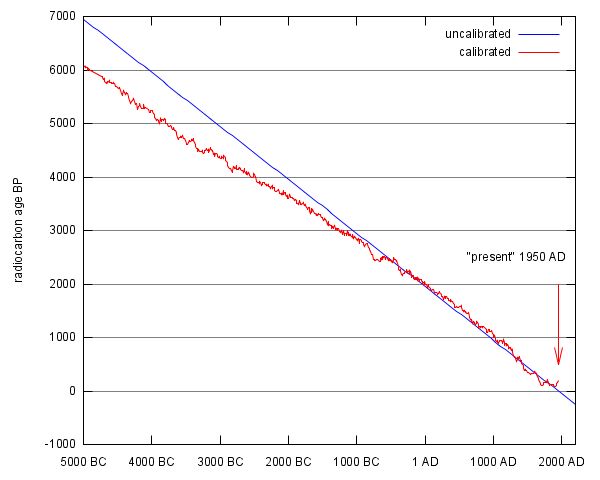Radiocarbon dating
Organic matter contains a certain amount of carbon-14, a radioactive isotope of carbon (under normal conditions carbon has an atomic weight of 12). Carbon-14 (14C ) is unstable, and degrades exponentially over time. All organisms have a certain amount of 14C present in their bodies – it is absorbed out of the atmosphere by plants during the process of photosynthesis, and transferred to animals when the plants are eaten. While alive, organisms experience a balance of 14C intake and dissipation. When an organism dies, the intake of 14C ceases, and what was left in the organism begins a measurable disintegration. Carbon-14 has a half-life of 5730 years (±40 years), meaning that (in accordance with the law of radioactive decay) it will take that length of time for half of the carbon present in an organism to decay into stable carbon isotopes. The levels of 14C present in a specimen can be measured in a variety of ways; however the invention of accelerator-based mass spectrometric techniques have drastically increased measurement accuracy, as it provides a count of the number of 14C atoms present in a sample. It has been used to date specimens up to 60,000 years in age. This analysis provides a radiocarbon age of the sample, which must then be calibrated in accordance with a radiocarbon dating calibration curve such as the one pictured below. A variety of factors have caused the amount of 14C present in the atmosphere to vary over time, resulting in deviations between the age predicted by radiocarbon dating and the absolute date of a specimen. Calibration curves correct for such variations. Sample contamination must be carefully avoided to ensure measurement accuracy. Carbon dating produces the most reliable results when multiple samples can be tested to ensure accuracy and limit potential interferences. Alternative dating techniques such as dendrochronology may be employed to confirm the results of radiocarbon dating.
Calibration Curve
 Image Source: “Radiocarbon Dating”. Wikipedia: http://en.wikipedia.org/wiki/Radiocarbon_dating, 2007.
Image Source: “Radiocarbon Dating”. Wikipedia: http://en.wikipedia.org/wiki/Radiocarbon_dating, 2007.
Sources:
Biers, William R. “The Archaeology of Greece”. Cornell University Press, Itha
“Dating In Exposed and Surface Contexts”, ed.: Beck, Charlotte. University of New Mexico Press: Albuquerque, NM, 1994.
Michels, Joseph. “Dating Methods in Archaeology”. Seminar Press, New York: NY, 1973
“Radiocarbon Dating”. Wikipedia: http://en.wikipedia.org/wiki/Radiocarbon_dating, 2007.
Posted at Dec 22/2007 09:58AM:
KYL: This is pretty cool. I was always curious about the carbon dating. Thanks for good info=)
